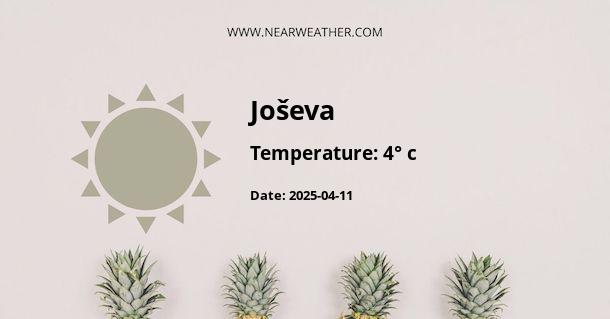Understanding the Climate and Weather Patterns in Joseva, Rio Grande do Sul
The city of Joseva in the southern Brazilian state of Rio Grande do Sul is characterized by a subtropical climate that presents varying weather conditions throughout the year. This region experiences four distinct seasons, with a notable range of temperatures and precipitation levels. In this weather-focused exploration, we will delve into the climatic specifics of Joseva, RS, examining temperature trends, rainfall patterns, weather events, and the implications these have for residents and visitors alike.
Seasonal Weather Variations
Joséva's geographical position at the southern edge of Brazil, near the border of Uruguay and Argentina, lends its climate subtropical characteristics with temperate influences. The seasonal variations are quite pronounced due to its location in the Southern Hemisphere.
Temperature
The temperature in Joseva typically ranges from mild to warm throughout the year.
- Summer (December to February): Joseva experiences its warmest months in summer, where average temperatures hover around 25°C to 30°C, occasionally reaching higher peaks when heat waves occur. The warm weather is often accompanied by higher humidity levels, which can enhance the sensation of heat.
- Autumn (March to May): As autumn sets in, temperatures gradually decrease. The average temperature during this season ranges from 15°C to 25°C, providing a pleasant and mild climate.
- Winter (June to August): Winter brings cooler weather to Joseva, with average temperatures dropping to 10°C to 16°C, though sometimes it can dip even lower, especially at night. Frost may occur, and sporadic cold fronts called "friagem" can bring a sharp, brief chill to the region.
- Spring (September to November): Spring witnesses a gradual warming trend as Joseva moves towards summer with average temperatures between 15°C and 25°C. It is characterized by a mix of rain and sunshine as the landscape revives.
Precipitation
Joséva's climate is marked by evenly distributed rainfall throughout the year.
| Season | Average Rainfall (mm) |
|---|---|
| Summer | 130-160 |
| Autumn | 120-140 |
| Winter | 100-120 |
| Spring | 130-150 |
It can be observed from the table that while there is a slight dip in the precipitation levels during the winter months, Joseva does not experience a dry season that is typical for many subtropical areas.
Extreme Weather Events
Joseva is subject to occasional extreme weather events, which can have significant impacts on the region.
- Thunderstorms: Given its subtropical location, Joseva is prone to thunderstorms, especially during the summer months when the interplay of heat and moisture is conducive to storm development.
- Hail: Hailstorms, although not extremely common, can occur. They are often the result of powerful thunderstorms, particularly in the spring and summer seasons.
- Cold Snaps and Frost: During the winter, cold snaps can be severe enough to bring frost, which can impact agriculture and daily life.
Climate Factors Influencing Joseva's Weather
The climate of Joseva is influenced by a combination of topographical, oceanic, and atmospheric factors:
- Latitude: Located at around 30 degrees south latitude, Joseva lies in a transitional zone between the tropical and temperate climates, which accounts for its mixture of weather patterns.
- Altitude: Despite being in a predominantly plain region, slight altitude variations in and around Joseva can affect local weather conditions, such as temperature and fog.
- Ocean Influence: The proximity of the Atlantic Ocean to the east helps moderate temperatures, particularly during the summer and winter extremes.
- La Niña and El Niño: These periodic climate phenomena in the Pacific Ocean can have a significant impact on weather patterns in Joseva, affecting both temperature and precipitation.
Implications for Agriculture and Tourism
The weather in Joseva has important implications for its economic activities, most notably agriculture and tourism:
Agriculture relies heavily on the region's favorable climate, with rainfall well distributed throughout the year and mild temperatures supporting a variety of crops.
- Viticulture: The wine industry thrives in the region due to the favorable climate, with distinct seasons providing a good balance of warm summers and cool winters that are ideal for different grape varieties.
- Other Crops: Crops such as soybeans, corn, and wheat benefit from the fertile soils and climatic conditions.
Tourism in Joseva is seasonally driven, with attractions and activities varying based on the weather conditions.
- Summer: Warm temperatures attract visitors to outdoor activities such as hiking and visiting nearby waterways.
- Winter: Cooler weather is ideal for exploring cultural activities, wine tours, and enjoying the region's culinary delights.
Concluding Insights
In sum, Joseva's climate is a tapestry woven with subtropical threads, yielding a rich pattern of weather that shapes the livelihoods and leisure of its inhabitants. A closer look at statistical climate data offers a clear picture of the nuanced interplay between the sun's wrath and the sky's bounty. Those wishing to set down roots or simply bask in the transient glow of tourism would do well to heed the climate's intricate dance—a partner in both prosperity and pleasure.
Understanding the climate and weather patterns of Joséva, RS is crucial for planning and preparedness, especially in sectors that are highly dependent on weather conditions. Adaptation and resilience to weather extremes are essential components of local planning, as they can minimize adverse impacts and capitalize on the region's weather diversity for economic and recreational purposes.
A - Joševa's Latitude is 44.586391 & Longitude is 19.408331.
A - Weather in Joševa is 4° today.
A - Climate Conditions in Joševa shows overcast clouds today.
A - Humidity in Joševa is 65% today.
A - Wind speed in Joševa is 4.72 km/h, flowing at 292° wind direction. today.
